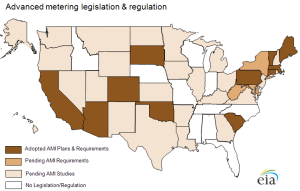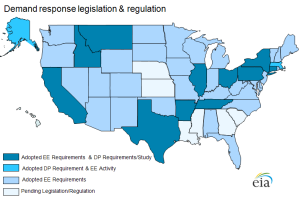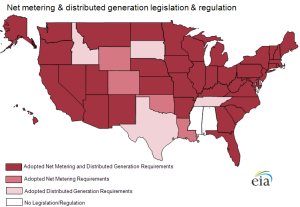Smart Grid Legislative and Regulatory Policies and Case Studies
Release date: December 12, 2011
In recent years, a number of U.S. states have adopted or are considering smart grid related laws, regulations, and voluntary or mandatory requirements. At the same time, the number of smart grid pilot projects has been increasing rapidly. Recent activity includes the deployment of smart meters, distribution automation and demand response (DR) programs. This increased activity is supported by the disbursement of almost $4.5 billion of American Recovery and Reinvestment Act funding targeted specifically to smart grid initiatives. Federal mandates are promoting smart grid projects, specifically Energy Independence and Security Act of 2007, Title XIII, which establishes a national policy for grid modernization and provides incentives for stakeholders to invest in smart grid initiatives.
In 2010, EIA commissioned SAIC to research the development of smart grid in the United States and abroad. The research produced several documents that will help guide EIA as it considers how best to track smart grid developments.
U.S. State Legislative and Regulatory Policies
Attachment A is a summary by state of legal and regulatory requirements related to the smart grid. The document contains three U.S. maps that show how activities in the states are progressing. (Maps shown on right.) The report contains a summary of legislative and regulatory activity in each state and also contains links to the resource material used to construct the summaries.
These state smart grid-related activities are centered on smart meters (Advanced Metering Infrastructure), data privacy issues, opt out policies and regulations promoting net metering and distributed generation programs. In addition, associated programs are discussed, such as energy efficiency goals and requirements, dynamic pricing policies and demand response programs. For many states, the document also includes a discussion of key drivers of increased activity.
U.S. Smart Grid Case Studies
Attachment B provides 23 case studies of smart grid pilots and programs in the U.S. It provides a sample of projects chosen to provide a variety of smart grid applications and approaches. These involve various technology types, pricing programs, and funding mechanisms. Each case study begins with a table that outlines important elements of the project and presents quantitative results and metrics when available. The tables are followed by more detailed descriptions of the projects, along with further supporting information.
The case studies are divided into two distinct sections: the first, “Successful or Progressing Projects,” comprises 13 case studies, and the second, “Cancelled or Postponed Projects,” comprises 10 case studies. The first section provides examples of projects that have been completed successfully or are in progress with no significant delays or difficulties.
The second section covers examples of projects that have been completely cancelled or significantly postponed, or that have suffered serious setbacks, due to any number of factors, including technological difficulties, customer complaints, funding problems, etc. In most cases, the public utility commissions (PUCs) or other bodies overseeing the projects have stipulated that these programs may continue as long as certain criteria are met, such as modifying a dynamic pricing structure or solving technical difficulties. The project case studies in the second grouping contain additional information, including a discussion of the reasons for the cancellation or postponement of the project.
International Smart Grid Activities
Attachment C contains research on international smart grid projects and looks at whether or not there are lessons to be learned that could benefit the U.S. and/or how developments in the United States may proceed.



